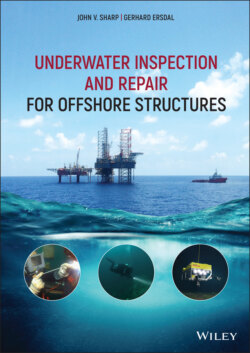Читать книгу Underwater Inspection and Repair for Offshore Structures - Gerhard Ersdal - Страница 15
1.3 Types of Offshore Structures
ОглавлениеInspection and repair depend on the type of structure and the material used. The types of platforms primarily used in the offshore industry are fixed with some variation and floating platforms. Examples of offshore structures are shown in Figure 4 and Figure 5.
Figure 4 Examples of types of offshore structures: (a) is a jack‐up placed alongside a jacket structure, (b) is a jacket structure, (c) is a concrete gravity‐based structure and (d) is a semi‐submersible unit.
Source: Sundar, V. (2015), Ocean Wave Mechanics: Application in Marine Structures, © 2015, John Wiley & Sons.
Figure 5 Various forms of wind turbine substructures: (a) suction pile caisson, (b) gravity‐based concrete foundation, (c) monopile, (d) tripod, (e) fixed steel structure (jacket), (f) tension leg platform, (g) spar buoy.
Source: Bhattacharya, S. (2019), Design of Foundations for Offshore Wind Turbines © 2019, John Wiley & Sons.
Fixed platforms typically are of the type:
fixed steel structures (jacket structures), which are mostly pile supported or suction anchor supported;
concrete gravity‐based structures;
jack‐ups; or
monopile.
Floating platforms are in general dependent on their watertight integrity and station keeping in addition to their structural integrity to function. The most used types of floating structures in the offshore industry include:
semi‐submersible platforms (mostly in steel, but one in concrete exists);
tension leg platforms (mostly in steel, but one in concrete exists);
ship‐shaped platforms and barge‐shaped platforms (mostly in steel, but a few in concrete have been made); and
spar platforms.
Structures must adhere to regional regulations (stationary structures) or to flag state regulations in combination with class society rules (mobile units). So‐called mobile offshore units (MOUs) are typically at a location for a limited time and inspection and repair are often performed at a yard at regular intervals. These yard periods allow for inspection and repair to be performed in controlled circumstances, often in dry conditions or benign conditions. In comparison, inspection and repair of stationary structures requires inspection and repair to be performed in an offshore environment and often underwater by an ROV. Hence, inspection and repair are rather different for these two types of structures, both with regards to the regulatory regime and the environment in which the inspection and repair is performed.
